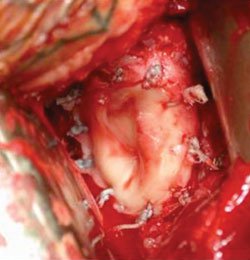Biologic resurfacing of the glenoid shows high failure rate in young, active patients
SAN DIEGO — Biologic resurfacing of the glenoid in young patients with glenohumeral arthritis carries an “unacceptable” failure rate, according to a study investigator.
Although Eric Jason Strauss, MD, and colleagues noted initial improvements in clinical results, he reported during his presentation at the 2011 Specialty Day of the American Orthopaedic Society for Sports Medicine that the overall clinical failure rate was greater than 50% at the intermediate term follow-up.
“Biological resurfacing of the glenoid with concomitant humeral head hemiarthroplasty has been used as a potential treatment option for young patients with glenohumeral arthritis,” Strauss said. “While the durability of biological resurfacing has been reported, other studies have described contrasting results — including continued pain and a rapid deterioration of postoperative functional outcomes.”
Failure rates
|
Images: Strauss EJ |
Strauss and his team studied 45 patients with a mean age of 42.2 years who underwent biologic resurfacing of the glenoid with either lateral meniscal allograft or human acellular dermal tissue matrix. The patients were followed for 2.8 years on average. Forty-one patients, including 31 who received lateral meniscal allograft and 10 who received acellular dermal tissue matrix, were available for follow-up evaluation.
Failure — defined as actual or recommended conversion to total shoulder arthroplasty, revision surgery for graft removal, or patient-reported disabling pain/loss of function — was reported in 21 of the 41 patients, contributing to a clinical failure rate of 51.2%.
The failure rate in the lateral meniscal allograft interposition group was 45.2%. Patients in the human acellular dermal matrix interposition group experienced a failure rate of 70%. Mean time to failure was 3.4 years and 2.2 years, respectively. Nine patients, he added, did not make it to the 2-year mark before failure.
“Overall, we believe that a clinical failure rate of greater than 50% is unacceptable in a young, active patient population — and the suggested benefit of decreased revision rate does not offset the poor results,” Strauss said.
No role for biological resurfacing
Strauss noted that patients experienced significant improvements in pain, shoulder outcome scores and shoulder motion when compared with their preoperative marks, but added the failure rate was simply too great to confidently recommend the procedure.
“The findings of our study suggest that biological resurfacing of the glenoid may not have a role in the treatment of glenohumeral osteoarthritis in young, active patients and should be carefully considered in the discussion of potential treatment options,” Strauss concluded. “That said, further study is necessary to better identify patients who will respond to biologics as a bridge for glenoid treatment.” – by Robert Press
Reference:
- Strauss EJ, Salata MJ, McGill K, et al. The high failure rate of biologic resurfacing of the glenoid in young patients with glenohumeral arthritis. Paper #9756. Presented at the 2011 Specialty Day of the American Orthopaedic Society for Sports Medicine. Feb. 19. San Diego.

- Eric Jason Strauss, MD, can be reached at Suite 1402, Department of Orthopaedic Surgery, NYU Hospital for Joint Diseases, 301 East 17th Street, New York, New York 10003; email: eric.strauss@nyumc.org.
- Disclosure: The authors have no relevant financial disclosures.

